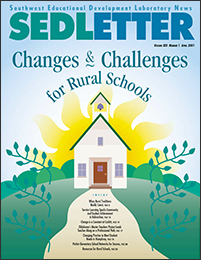General Information The ERIC Clearinghouse for Rural Education and Small Schools may be found at http://www.ael.org/eric/rural.htm. (Note: site no longer available 7/2004) Many summaries of publications and articles are online; print copies of complete publications and article may be ordered at a reasonable cost. Currently available for downloading free of charge are hands-on science and math projects for middle school students. Pulling Together: R&D Resources for Rural Schools, a collection of research and development resources for educators who work in rural settings is available online at http://www.ncrel.org/rural/. The resources, which are a product of the National Network of Regional Educational Laboratories, include Web sites, publications, training programs, model programs, and services. Each list of resources is preceded by an overview that outlines the topic and tells why it is important to educators in rural areas. The Pulling Together Web site also contains a research document that examines the condition of education in rural America. Pulling Together: The Rural Circumstance looks at issues like the changes currently taking place in rural America, the role of educational research & development, and the different aspects of implementing and managing change in rural schools. Service Learning Learning In Deed: Making a Difference Through Service Learning, is an initiative of the W. K. Kellogg Foundation that aims to engage more youth in service to others as part of their academic experience. The Web site http://learningindeed.org/ offers examples of service learning projects, links for policymakers and researchers, and a special resource section for teachers. Shumer's Self-Assessment for Service Learning is available online at http://www.servicelearning.org/. This collection of instruments and worksheets can help schools, districts, or communities evaluate their service learning projects. Such evaluations are helpful when determining how to improve your program or when trying to secure funding. The assessment guide was tested for three years with service learning practitioners in eight states before being released in December 2000. Author Rob Shumer is the director of the Learn and Serve American National Service-Learning Clearinghouse, based at the University of Minnesota. Find the Service Learning Quarterly online at http://www.closeup.org/. A recent issue of Service Learning Quarterly includes brief articles on curriculum infusion, meeting community needs, and suggestions for student reflection on their service learning projects. Student Mental Health Issues The Web site for UCLA's Center for Mental Health in Schools, http://smhp.psych.ucla.edu/, covers a variety of student mental health issues and includes dozens of links and PDF files that may be downloaded. Some of the topics on this resource-laden site include "Dropout Prevention," "Teen Pregnancy Prevention and Support," "School Interventions to Prevent Youth Suicide," "Understanding and Minimizing Staff Burnout," and "Screen/Assessing Students: Indicators and Tools." The Center also offers a staff development curriculum on how to design regular classrooms and schools to ensure all students have appropriate opportunities to learn effectively. After-School Programs Compiled by Janet Hall Bagby and published by the Southwest Educational Development Laboratory, A Resource Guide for Planning and Operating After-School Programs provides descriptions and costs of resources available to help support after-school programs. Topics include management, communication, programming, community building and collaboration, and developing connections between K-12 education and after-school programs. The resource guide may be searched online or downloaded in PDF format at http://www.sedl.org/pubs/fam95/. Beyond the Bell: A Toolkit for Creating Effective After-School Programs is a practical guide to setting up an after-school program in schools large and small. It includes numerous worksheets that cover topics from setting goals to preparing an evaluation to creating an information form to be shared between the student's classroom teacher and after-school program tutor. Published by the North Central Regional Education Laboratory, Beyond the Bell is available online at http://www.ncrel.org/after/bellkit.htm. School Improvement and Community Development SEDL recently released Thriving Together: Connecting Rural School Improvement and Community Development, a practical guide for schools or community organizations that want to undertake activities or programs beneficial to both the school and community. It provides tips for building effective teams, starting service-learning or entrepreneurial education projects, and transforming a school into a community center. This user-friendly guide also includes project planning worksheets and checklists, background information, fact sheets, and additional resources. Thriving Together is available in print ($39.95) or on CD-ROM ($29.95). It is also available in print in Spanish, entitled Prosperando Juntos. Ordering information may be found at http://www.sedl.org/pubs/ catalog/items/fam22.html. (Benefits2) is a series of six issue papers published by SEDL during 1999 and 2000 for participants in its Rural Development Collaborative Action Team project. The papers cover a range of school improvement and community development topics but focus on service learning and entrepreneurial education as ways to link the community and increase student achievement. The issues may be found online at http://www.sedl.org/prep/benefits2/. | 
